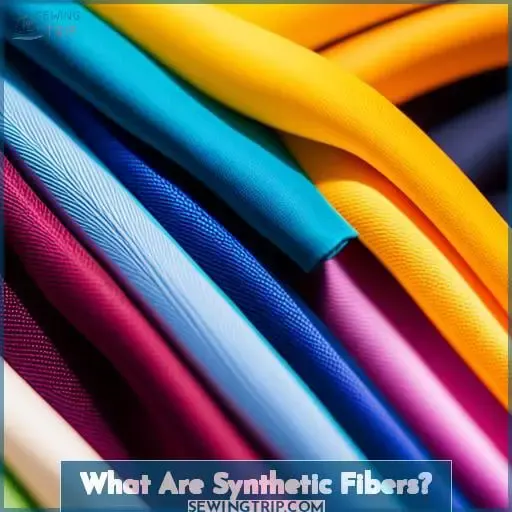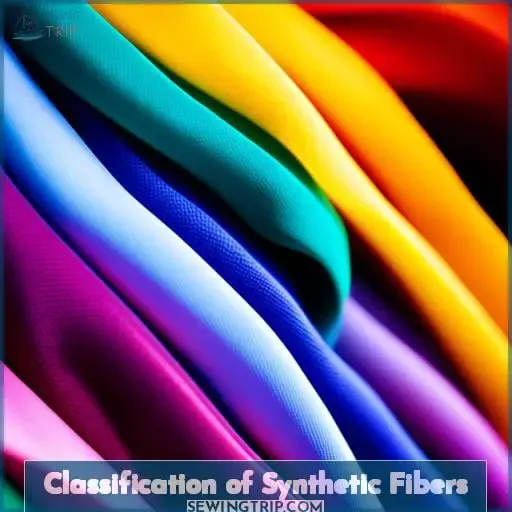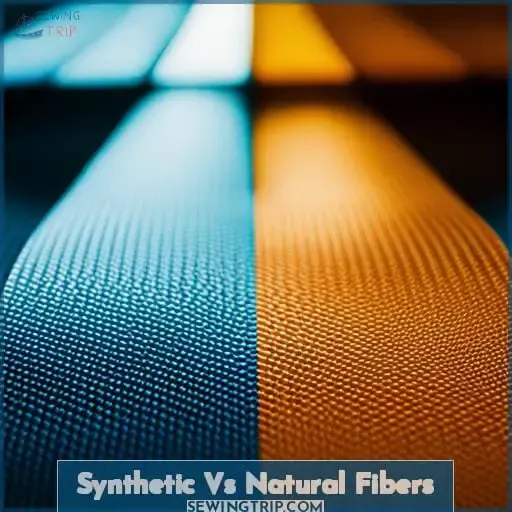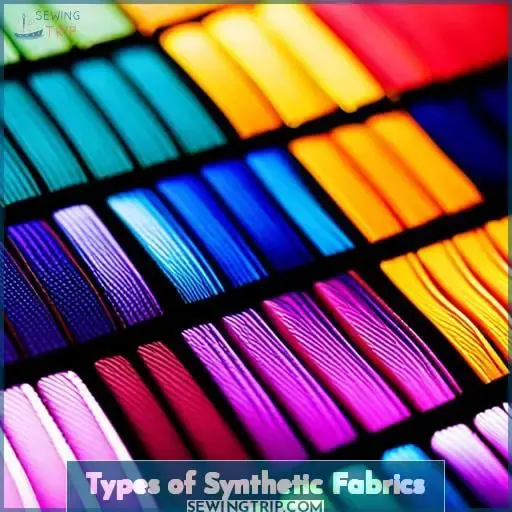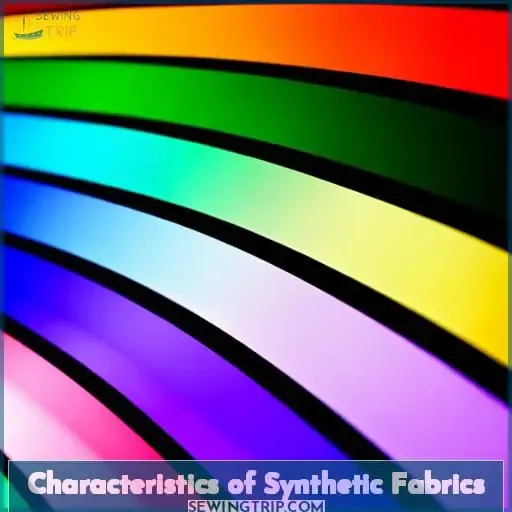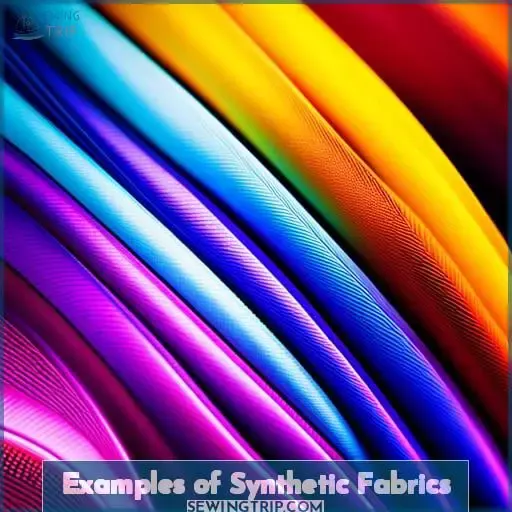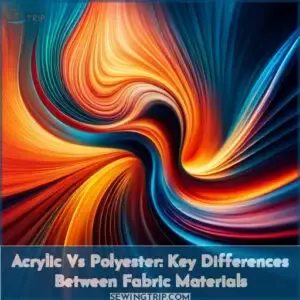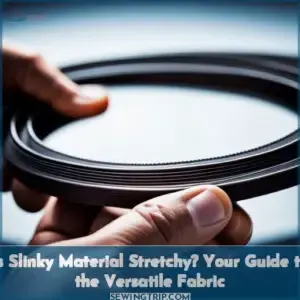This site is supported by our readers. We may earn a commission, at no cost to you, if you purchase through links.
Are you looking for an extensive list of synthetic fabric types? According to a report from Market Research Future, the global market size of synthetic fiber is projected to expand at a compound annual growth rate of 7.
Synthetic fabrics are materials made through chemical synthesis and processes, designed to mimic natural fibers and fabrics but with their own unique characteristics.
In this article, we will take a comprehensive look at all the different types of synthetic fabric available on the market today, as well as their individual properties.
Table Of Contents
Key Takeaways
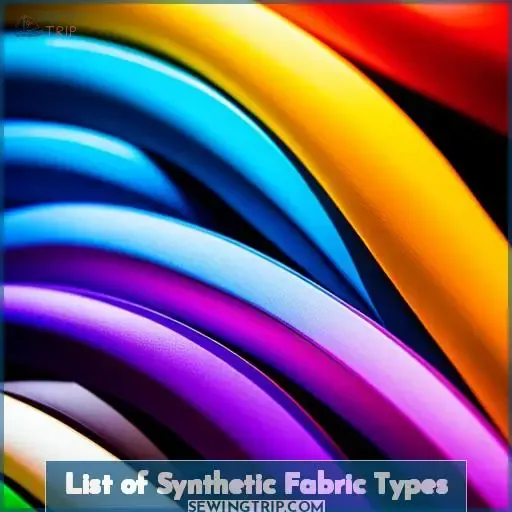
- Synthetic fibers are created through chemical synthesis to imitate natural fibers with unique characteristics.
- There are completely synthetic and semi-synthetic fibers available, with common varieties including polyester, nylon, spandex, and acrylic.
- Synthetic fabrics possess anti-wrinkling, anti-shrinking, and anti-pilling properties, but they are also non-biodegradable and can take over 200 years to decompose, contributing to environmental pollution.
- Synthetic fabrics can be recycled, but eco-friendly alternatives to synthetic fabrics such as bamboo or hemp fabrics are available and should be considered due to the negative environmental effects of synthetic fabrics.
What Are Synthetic Fibers?
You may not realize it, but many of the clothing and accessories you wear every day are made from synthetic fibers. These materials have been chemically synthesized to replicate the properties of natural fabrics.
Synthetic fibers are man-made products created through chemical synthesis rather than naturally derived from living organisms.
These materials can be used for a range of applications such as ropes, fishing nets, seat belts, and jackets due to their strength and durability compared with traditional natural alternatives. Polyethylene terephthalate is one example that is widely used in production processes due to its ability to be easily spun into filaments or yarns while retaining fabric strength even when exposed to extreme temperatures or harsh chemicals.
Such synthetics also offer eco-friendly alternatives over those traditionally sourced from animals or plants. Plus, they can provide more vibrant colors without compromising on performance characteristics like fire retardancy or breathability either! In summary, these modern synthetic fabrics offer far greater versatility than ever before by providing designers with an array of options for creating unique styles that stand out amongst competitors while still delivering high levels of protection against environmental threats.
Classification of Synthetic Fibers
You may not be aware, but there are two main types of synthetic fibers: completely synthetic and semi-synthetic. Completely synthetic fibers are created through chemical synthesis rather than being derived from living organisms, while semi-synthetic fibers use both natural and man-made materials.
The range of options available in the market today is vast; from rayon to vinyl to microfiber – you can find a wide variety of fabrics with special characteristics like anti-wrinkling or anti-stretching properties, all tailored for specific uses.
Completely Synthetic Fibers
Discover the characteristics of completely synthetic fibers, from rayon to nylon and polyester – all designed for a range of uses that deliver performance, versatility, and vibrant colors. Synthetic fibers are man-made products created through chemical synthesis with chemicals derived from petroleum products.
Filament production is brought about by spinning processes, while yarns require chemical solutions. Synthetic fibers offer heat resistance, allowing usage in items such as stockings, socks, and umbrellas.
However, they can be dangerous if exposed to fire due to their melting properties. Their environmental impact is lower than natural fibers, which must be taken into account when considering application uses or dyed colors for fashion garments or upholstery purposes.
Ultra-high molecular weight polyethylene fibers offer strength without compromising on flexibility, making them ideal for rope climbing activities like rock climbing or parachuting.
Semi-Synthetic Fibers
Semisynthetic fibers are the perfect balance of natural and man-made materials, offering both strength and flexibility for all your needs. They can be produced from a combination of petroleum products and natural fibers such as cotton or wool, making them more lightweight than most synthetic fabrics.
The production process involves spinning to create filaments that require chemical solutions when making yarns. Benefits include being resistant to heat while also providing better breathability compared to fully synthetic materials like polyester or nylon.
Microfibers made from semi-synthetic material are especially useful for cleaning sensitive items around the house due to their gentle nature yet still providing strong resistance against dirt particles adhering onto surfaces.
Synthetic Vs Natural Fibers
Compare the differences between natural and synthetic fibers. From their origin to their properties, you’ll find that they each have unique qualities. Natural fibers are derived from plants or animals, whereas man-made fibers come from chemical substances via polymerization.
The structure of a natural fiber is determined by its source, while synthetic materials can be designed for specific uses. For example, nylon has high tensile strength and elasticity, making it ideal for ropes used in rock climbing or parachutes.
Fabric production with both types also differs significantly. Natural fabrics require spinning and weaving processes using raw material, while synthetics are created through chemical synthesis without any need to draw on living organisms’ resources.
Environmental effects should also be considered when choosing either type. Despite being biodegradable, some natural fibers may cause environmental damage due to pesticides used during cultivation, while others like polyester take over 200 years before finally disappearing in landfills once discarded after use.
Ultimately, your choice will depend upon factors such as cost-effectiveness versus higher quality, plus special characteristics needed, including anti-wrinkling or shrinkage resistance when selecting either a natural yarn/fabric like cotton over a synthetic alternative made of acrylics, microfiber, etc.
Types of Synthetic Fabrics
You may be familiar with the most popular types of synthetic fabrics, such as polyester, nylon, spandex, and acrylic. However, did you know that there are actually a variety of other synthetic fabrics out there? From rayon to viscose and bamboo, these materials all have unique properties that make them ideal for certain applications.
Polyester
You’ll be amazed at the strength and durability of polyester, a synthetic fabric that’s stronger than steel wire! This lightweight material is highly resistant to unraveling, and it won’t shrink or stretch when wet.
Polyester has unique fiber properties. For instance, clothes made from this fabric will keep their shape even after multiple washes due to its excellent elasticity. Processing techniques, such as melt spinning, are used in its production, making polyester an eco-friendly alternative compared to different types of synthetic fibers that have a longer decomposition process in landfills.
However, it’s important to note that polyester melts on heating, so caution should always be taken while using garments with this type of fiber content.
Nylon
Nylon is a superior synthetic material made from chemicals derived from petroleum products. Its polyamide structure makes it durable and strong, perfect for making stretchy garments like stockings and socks.
It’s known to be resistant to shrinking, wrinkling, abrasion, and mildew. Nylon also offers an advantageous weight-to-strength ratio. Other advantages include being easy to dye into vibrant colors or even print on its surface with relative ease.
However, some of the drawbacks of nylon fabric are that it can melt in high temperatures or when exposed to certain types of chemicals such as bleach or solvents. These factors may cause discoloration over time if not treated properly. Popular brands utilizing this type of fabric are Lycra®, Spandex® (polyurethane), Polyvinyl Chloride (PVC), among others.
Spandex
You’ll appreciate the stretch and comfort of spandex fabric. In fact, it can be stretched up to five times its original length before returning to its normal size. This durable synthetic material is a registered brand name for elastane, utilizing natural polymers that make it soft yet strong.
Its properties are similar to rayon, but with more strength than nylon or polyester, which offers advantages such as anti-wrinkling and easy washing capabilities.
Spandex is often used in athletic wear due to its flexibility, while acrylic is popular for creating static electricity when touching skin. Microfiber also utilizes this type of fiber, making it nice and soft against sensitive objects like glasses or screens while also being lightweight compared to other fabrics like cotton or wool.
Spandex is an incredibly versatile fabric with endless possibilities, so you will find utilization from clothing items such as lingerie, outdoor wear, formal attire, among many others! Designers must take into consideration the length of the fibers when selecting this type of material for their next project, as it determines how much elasticity each garment has.
Acrylic
Acrylic is an ideal fabric for clothing if you’re looking for a lightweight, wrinkle-resistant material with static electricity protection. This man-made synthetic fiber is derived from petroleum products and has properties similar to wool.
It’s strong yet soft and can be dyed in many colors. Its durability makes it great as formalwear or outdoor apparel, while its stretchability offers comfort when used in lingerie or athletic costumes.
Acrylic also resists shrinking and pilling more than nylon or polyester fabrics do. This, combined with microfiber uses, lends itself to cleaning sensitive objects like glasses without scratches! Natural fibers such as cotton have a fixed length, but acrylic has a controlled length which helps create fine filaments that are useful for composite materials where the orientation of fibers matters significantly due to geological processes or animal resources.
Characteristics of Synthetic Fabrics
You may not be aware of the many advantages synthetic fabrics have to offer. For instance, they can come with anti-wrinkling, anti-shrinking, and anti-pilling properties that make them very popular for a variety of uses.
Furthermore, these fabrics are available in an array of styles, from rayon to viscose and bamboo, so you’re sure to find one that works best for you.
Anti-wrinkling
You may not have to worry about ironing your clothes if you use certain synthetic fabrics, such as polyester or spandex.
These fabric blends are also great for items like seat belts and parachutes, which require strength, as well as dyeing methods that retain their wrinkle-free fiber. Synthetic fabrics can be made using chemical solutions derived from petroleum products, with some even being stronger than steel wire.
From rayon and viscose all the way through microfiber, so many options are now at our fingertips when selecting materials that will make up our clothing or accessories while having minimal environmental impact along with optimal safety measures when exposed to heat.
Anti-shrinking
If you’re looking for a fabric that won’t shrink, then synthetic materials like polyester and spandex are your best bet. These fabrics have been designed to resist shrinking through chemical synthesis while maintaining their fiber strength.
There are many types of synthetic fabrics available, such as acrylic, rayon, nylon, microfiber, and Polar Fleece. They are made from petroleum products or wood pulp and combined with special properties like anti-wrinkling and lightweight dyes.
Additionally, these synthetics can be easily cared for using low temperatures, which avoids melting or deformation due to heat exposure. Synthetic fabrics offer versatility in terms of style yet lack the characteristics found in natural fibers, making them non-eco friendly if discarded into landfills where they may take up to 200 years to disappear completely.
Anti-pilling
Synthetic materials like polyester and spandex are designed with anti-pilling properties, so you can enjoy the fabrics’ versatility without worrying about pesky pills. These synthetic fabrics have many desirable characteristics, including heat resistance, dyeing properties, odor retention, and static electricity.
They are a great choice for many applications, and their chemical resistance allows them to be used in harsh environments where raw materials might not survive.
The most common types of synthetic fabric include acrylics, rayon, and nylon. Ultra-high molecular weight polyethylene fibers are considered to be the strongest of all synthetics available today.
Examples of Synthetic Fabrics
From acrylic to zippers, explore the world of synthetic fabrics for unique looks and superior performance.
Polyester is a popular choice due to its low cost and properties such as wrinkle-resistance. Rayon has also become more widely used due to its softer feel. Nylon offers strength with flexibility, while spandex provides elasticity that can be helpful for certain garments.
Acrylic may have drawbacks in terms of static electricity, but it still remains a common material because of its similarity to wool yet rarity among those natural fibers that are difficult or impossible for some people around the world to access.
There’s also poly linen, a combination fabric made from both polyester and linen, that allows you to best use all the advantages these different fabrics offer without having too much bulkiness or heaviness in your apparel pieces!
With so many options available when it comes to choosing synthetic materials over their counterparts, you’re sure to find something that fits your style needs perfectly!
Disadvantages of Synthetic Materials
You may not realize it, but synthetic fabrics are a major contributor to environmental pollution. Many of these materials, such as polyester, spandex, nylon, and acrylic, are non-biodegradable and can take over 200 years to finally disappear from landfills.
Additionally, some of these fabrics have been known to be toxic or dangerous for the person wearing them due to their petroleum-based makeup.
Non-biodegradable
You should be aware that synthetic fabrics are non-biodegradable and can take over 200 years to break down, making them unsustainable for the environment. These fabrics may offer certain advantages at a lower cost than natural fibers, but they come with health risks due to their chemical composition and fabric weaves.
Additionally, microplastics pollution is an issue as these materials do not degrade by natural processes.
If you want sustainable options, there are eco-friendly alternatives available which have been made from living organisms or other right materials such as bamboo or hemp fabrics. To ensure your clothing choices don’t harm our planet, check out lists of the different types of synthetic fabric.
Toxicity
Be aware that these fabrics may come with health risks due to their chemical composition and fabric weaves. Synthetic materials can be toxic when used in clothing, making them non-eco friendly. Chemical synthesis is required for the production of synthetic fabrics from petroleum products, which are not biodegradable and take over 200 years to decompose.
Static electricity is a main drawback when using acrylic fabrics, while heat resistance varies among different types of synthetic fibers or fabrics. Polyester should only be cleaned at low temperatures to avoid melting or deformation.
The best way to maintain your garment’s quality would be hand washing, as opposed to dry cleaning.
Cleaning Instructions
To ensure that your synthetic fabrics last longer, it’s important to follow the specific cleaning instructions for each fabric type. For instance, polyester should be washed at low temperatures to avoid melting or deformation.
But why risk damaging it if you can hand wash instead? Synthetic material care is also essential when it comes to fabric maintenance and durability. Fire safety is another factor to consider as these materials are more likely than natural fibers such as cotton or wool to catch fire easily due to their chemical composition and texture.
Be aware of the names of these fabrics so you know which ones need special attention when handling them outdoors.
Frequently Asked Questions (FAQs)
What are the environmental implications of using synthetic fabrics?
Using synthetic fabrics can have negative environmental effects due to their non-biodegradability. They take over 200 years to decompose, and the production of them is energy-intensive as well as damaging to the environment.
Additionally, synthetic fabrics are often treated with chemicals that may be hazardous if not properly disposed of afterward.
Are synthetic fabrics harmful to human health?
Synthetic fabrics may contain chemicals that can be harmful to human health if inhaled or absorbed through skin contact. Ongoing research is being conducted to determine the safety of these materials, so it is important to take precautions when wearing synthetic fabric.
Can synthetic fabrics be recycled?
Yes, synthetic fabrics can be recycled. Certain synthetics, such as polyester and nylon, are often melted down and turned into yarn or fabric to create new products. Recycling these materials helps reduce waste while still providing high-quality items.
How are synthetic fabrics produced?
Synthetic fabrics are produced using chemical synthesis, which involves combining chemicals derived from petroleum products. These chemicals are then spun into filaments and woven or knitted to produce various types of fabric, such as rayon, nylon, polyester, and acrylic.
Synthetics have unique characteristics, such as anti-wrinkling and anti-pilling, which often make them preferable to natural fibers.
What is the difference between synthetic fabrics and natural fabrics?
The primary difference between synthetic and natural fabrics is that synthetic fabrics are man-made, while natural fibers come from plants and animals. Synthetic fibers can be melted when heated, have a controlled length, and require a spinning process for production.
On the other hand, natural fibers do not melt when heated, have fixed lengths, but lack control over their orientation.
Conclusion
Now that you’ve learned about synthetic fibers, you’re likely wondering what the advantages and disadvantages are of using them. Synthetic fibers offer a great range of options and can be used for a variety of purposes.
However, they do have some drawbacks. For instance, they are non-biodegradable, toxic, and require special cleaning instructions to avoid melting and deformation.
On the other hand, synthetic fabrics can be made to mimic natural fibers and fabrics. This makes them a popular choice for those who want to look stylish without sacrificing comfort. Ultimately, it’s up to you to decide which type of fabric is best for your needs.

